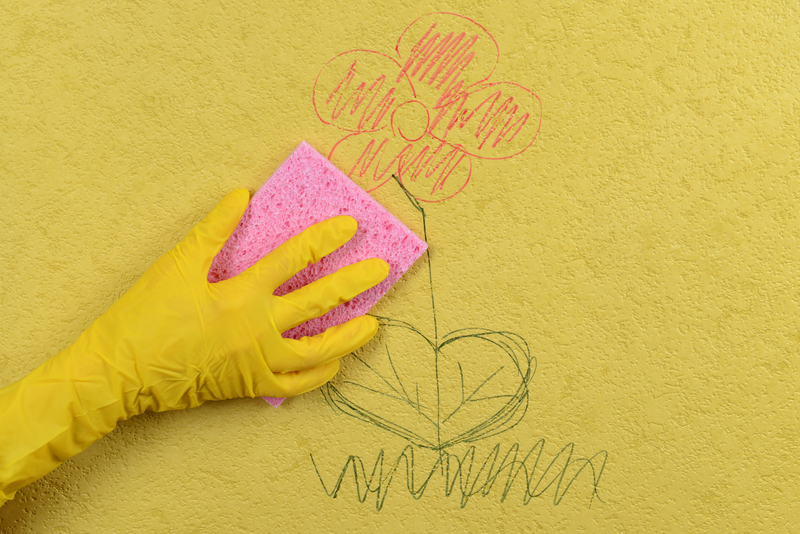Optimizing Curtain Longevity with Proper Cleaning Practices
Posted on 26/05/2025
Optimizing Curtain Longevity with Proper Cleaning Practices
Curtains are more than just decorative elements in your home; they function as filters for dust, sunlight, and sometimes even outdoor pollutants. Optimizing curtain longevity through proper cleaning practices ensures that your investment in window treatments continues to pay off aesthetically and functionally for years to come. Whether your drapery is made of silk, cotton, polyester, or intricate blends, understanding the nuances of curtain maintenance can mean the difference between faded, dulled textiles and vibrant, long-lasting window dressings.

Why Curtain Longevity Matters
Curtains often represent a significant financial investment and play a vital role in home ambiance. Over time, environmental factors such as sunlight, dust, pet dander, and moisture can degrade curtain fibers, dull their appearance, and compromise their structural integrity. Maximizing curtain durability not only preserves their color and texture but also upholds indoor air quality and home hygiene.
- Saves Money: Well-maintained curtains may not need to be replaced as frequently, reducing household expenses in the long run.
- Enhances Aesthetic Appeal: Clean, well-kept drapes uplift the look of every room, supporting your home's overall decor theme.
- Improves Health: Proper cleaning minimizes allergens and bacteria, particularly important for households with children, elders, or pets.
- Protects Against Damage: Maintenance can prevent issues like mold, mildew, or sun-related fabric weakening.
Understanding Curtain Materials and Their Cleaning Needs
Not all curtains should be treated equally. Certain fabrics require niche care, and using inappropriate cleaning methods can hamper your goal of prolonging curtain lifespan. Here's a quick overview of common curtain materials and their preferred maintenance approaches:
- Cotton: Durable and easy to wash, but may shrink if not handled properly. Gentle machine washing or hand washing is ideal.
- Linen: Breathable and elegant, but prone to wrinkling. Dry cleaning or careful hand washing with cool water is recommended.
- Polyester: Resistant to stretching and shrinking, but can attract static and dust. Regular machine washing works well.
- Velvet: Luxurious but delicate. Requires vacuuming with a soft brush attachment or professional dry cleaning.
- Silk: Highly sensitive; water and strong detergents can damage the fibers. Always opt for professional cleaning.
- Blends: Read the manufacturer's care label! Cleaning needs depend on the blend ratio and type.
Always consult curtain care labels before cleaning, or do a spot test with any new cleaning product or method.
How to Clean Curtains for Maximum Longevity
1. Regular Dusting and Vacuuming
Routine dust removal is the simplest yet most effective way to optimize curtain lifespan. Dust and dirt particles act like sandpaper on fabric fibers, hastening wear over time. By keeping dust at bay, you minimize abrasion and fabric fatigue.
- Use a vacuum cleaner with a soft brush or upholstery attachment on low suction setting.
- Run the attachment from top to bottom, focusing on folds and pleats where dust collects.
- For sheer, delicate, or very lightweight curtains, take extra care or use a handheld lint roller.
Aim to vacuum your curtains at least once a week, especially in high-traffic or high-dust areas.
2. Spot Cleaning Small Stains
Addressing stains immediately is crucial for
- Blot (do not rub) the affected area with a clean, damp cloth.
- Use a mild detergent mixed with water; always spot test on a hidden area.
- Avoid soaking the fabric--too much moisture can damage curtain linings or cause water marks.
3. Machine Washing Curtains
If your curtains are machine washable, use a gentle cycle with cool or lukewarm water and mild detergent to preserve curtain longevity. Avoid bleach or fabric softeners unless the care label says otherwise.
- Remove hooks, rings, and other hardware before washing to prevent damage.
- Wash curtains on their own--do not overload the washing machine.
- Shake them out after washing, and hang to dry immediately to reduce wrinkles.
- For delicate materials, place the curtain inside a large mesh laundry bag.
Never machine wash non-washable fabrics (silk, wool blends, or heavy velvet).
4. Hand Washing
Hand washing is best for more delicate curtains or those not labeled as machine washable. Fill a tub with cool to lukewarm water, add a gentle detergent, submerge the curtain, and move it gently.
- Do not wring out or twist the curtain--instead, press out the excess water gently.
- Lay flat or hang to dry, keeping the fabric in natural shape.
5. Professional Curtain Cleaning
Some window coverings (such as silk, **velvet**, or intricately embroidered panels) require expert care to avoid irreparable damage. Professional dry cleaning extends curtain lifespan by using specialized solvents and procedures that preserve color, structure, and feel.
- Always inform cleaners of any stains or fragile embellishments.
- Request non-toxic, eco-friendly solvents if available.
6. Steam Cleaning Curtains
Steam cleaning is a convenient way to revive curtains without taking them down. It refreshes fabrics and loosens light stains or dust. Use a handheld steamer and move in downward strokes from top to bottom, maintaining safe distance to avoid burns or water stains.
- Test a small area first to assess colorfastness.
- Open windows or turn on fans for quick drying, reducing the risk of mildew.
Best Practices for Maximizing Curtain Lifespan
1. Rotate Curtains Seasonally
If your home has sun-facing windows, consider rotating your curtains seasonally. This spreads out fabric exposure to sunlight, which can cause fading or breakage over time. Rotating also helps maintain even aging of the textile surface, keeping colors and patterns vibrant for longer.
2. Protect Curtains from Direct Sunlight
UV rays can quickly degrade curtain fibers and cause colors to fade. For sheer or light-colored window treatments, add a UV-protective liner or use blinds during peak sunlight hours. Investing in UV-blocking window films is another way to decrease curtain damage while still letting in natural light.
3. Address Moisture and Humidity Issues
Curtains in kitchens, bathrooms, or basements are more vulnerable to mold and mildew. Be proactive:
- Use exhaust fans to minimize moisture accumulation.
- Choose mildew-resistant fabrics for humid areas.
- Dry any damp curtains immediately in a well-ventilated area.
Regularly check your curtains' hems and seams for early signs of damage or mold growth.
4. Gentle Ironing or Steaming
Heat can rejuvenate curtains by removing creases and freshening the fabric. However, always check fabric care guidelines:
- Use a warm (not hot) iron for cotton or linen curtains, and iron on the reverse side if possible.
- For synthetic or delicate fabrics, opt for steaming instead.
Avoid exposing delicate fabrics to direct heat, as it can melt fibers or set stains.
5. Store Seasonal Curtains Properly
When not in use, store curtains in a cool, dry place. Avoid plastic bags, which can trap moisture and lead to mildew. Instead, fold curtains loosely and place them in breathable cotton storage bags or wrapped in acid-free tissue paper.
- Keep away from direct sunlight or heat sources, which can discolor or weaken fabric.
- Add lavender sachets or cedar blocks to deter pests such as moths.
6. Regular Checks and Minor Repairs
Sustaining your curtains' longevity also means dealing with small repairs before they become big problems. Reattach loose hooks, reinforce torn hems, and mend small holes promptly.
Common Mistakes That Shorten Curtain Life
To optimize curtain longevity, avoid these frequent mistakes:
- Overwashing: Excessive washing can cause fabric breakdown and color fading. Stick to a regular but moderate cleaning schedule.
- Using Harsh Chemicals: Bleach and other harsh cleaning agents can degrade even the toughest curtain fabrics.
- Neglecting Hardware: Rusty rods or rings can stain curtain fabrics and cause tears.
- Ignoring Manufacturer's Instructions: Care labels exist for a reason--follow them to maintain integrity and appearance.
- Poor Storage: Storing curtains in damp or compacted spaces can cause mildew and deep set creases.
How Often Should You Clean Curtains?
A comprehensive curtain cleaning routine varies depending on household factors such as pets, allergies, and environmental dust levels. As a general guide:
- Lightly-used rooms: Thorough wash or professional clean every 6-12 months.
- High-traffic or high-allergy homes: Every 3-6 months is best for dust and allergen control.
- Regular vacuuming: Once a week for all areas.
- Spot cleaning: As soon as stains or marks appear.
Never let your cleaning schedule slip too long--build consistent curtain maintenance into your home cleaning calendar.

Eco-Friendly Cleaning Practices for Extended Curtain Life
An increasing number of homeowners prefer environmentally friendly products and practices. Using green cleaning methods helps protect curtain fibers and supports global sustainability:
- Make a gentle cleaning solution using natural ingredients like white vinegar and mild soap.
- Choose phosphate-free and biodegradable detergents for washing.
- Avoid excessive water use; rinse curtains efficiently but thoroughly.
- Air dry whenever possible--machine dryers can weaken or shrink textiles.
Eco-friendly cleaning is often gentler on delicate materials, further contributing to optimized curtain lifespan.
Conclusion: The Key to Long-Lasting Curtains
Beautiful, functional curtains are only as enduring as the care you invest in them. By following these proper cleaning practices for curtain longevity, you not only keep your window treatments looking fresh, but also minimize allergies and extend fabric life span. Tailor your cleaning and maintenance to the material, use eco-friendly cleansers, and avoid common care mistakes. Whether you do this yourself or partner with professional services, thoughtful curtain maintenance delivers rewards in both aesthetics and practical value for years to come.
Implement these expert strategies, and watch your curtains stand the test of time, season after season.




